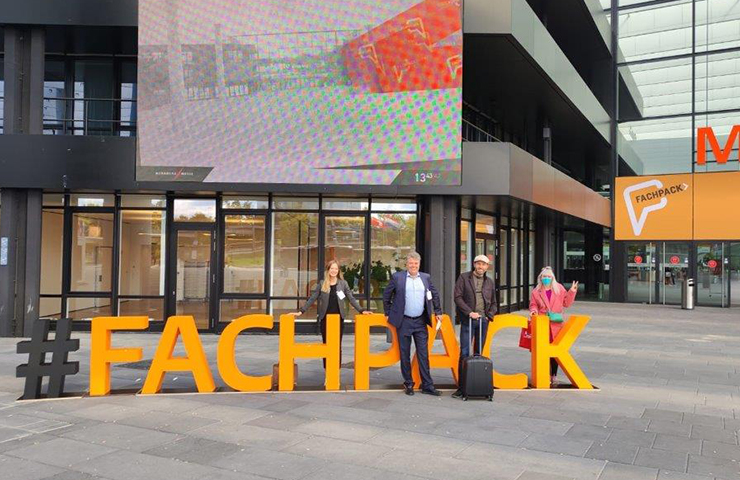Fachpack 2021 - The Most Important Trends and Topics for the Print and Packaging Industry

Fachpack, the trade fair for packaging, processes and technology takes place every year in Nuremberg, Germany. After the Covid-19-related cancellation of the fair last year, about 24,000 visitors and more than 750 exhibitors from 33 countries were able to enjoy it again this time. We’ve picked up and summarized the current trends and topics discussed at the fair, as well as expectations in the print and packaging industry.
Climate protection, sustainability and the recycling economy
At Fachpack, topics are addressed that have already been a major concern for the industry for years: climate protection and sustainability. Another important issue is the recycling economy, to not only handle new resources sustainably but also keep reusing them. A study conducted by WWF and Systemiq and presented at Fachpack showed: 89% of all plastic packaging in Germany still consists of new material, and 50% of packaging waste is burned after single use. Thus, valuable resources for a recycling system get lost, and the proportion of recycled and reused materials is still vanishingly small. Over the course of the next couple of years, legislative proposals are expected to be made, with the aim of minimizing the amount of plastic waste and reducing greenhouse gas emissions. Statutory requirements and regulations currently do not only obligate packaging manufacturers to give due consideration to the disposal of their products - they also comprise requirements regarding a mandatory proportion of recyclate in production. This is for example already the case for PET bottles. Besides legislation, however, there is also the end consumers who expect more and more sustainable production of packaging material. This is evidenced above all by more and more conscious consumer behavior and an increased demand for sustainable products.
Illegal waste disposal also wastes raw materials that could otherwise be reused in the circulatory system. Tamara Kornfeind’s blog discusses which measures are being taken to prevent this pollution in Switzerland.
Sustainable packaging material
In line with sustainability, there is a clear trend when it comes to packaging material. Mono-materials or easily separable materials play an important role in this regard, as they help to optimize the recycling process and extend the life cycle of the materials and save resources. Alternative packaging materials such as paper and biodegradable packaging were presented by many exhibitors at the fair. According to a current trend survey at Fachpack (Trendradar), biodegradable or compostable packaging is less relevant than materials that can be recycled and can thus be fed back into the material cycle. Be aware though that biodegradable doesn’t always mean compostable. Myths such as this are addressed in Tamara’s blog post (7 myths about waste separation | COSMO CONSULT)
Packaging innovation: active, intelligent and smart packaging
In the packaging industry, innovative solutions such as active, intelligent and smart packaging are increasingly being used. But what exactly do we mean by these terms? Active packaging contains components such as oxygen and ethylene absorbers as well as antimicrobial substances and antioxidants to improve the quality and extend the shelf life of foods. Intelligent packaging refers to packaging systems with integrated sensor technology, which are increasingly being used for food and medication. They make use of hardware components such as radio-frequency identification systems (RFID), gas detectors, temperature indicators or freshness indicators. With this technology the shelf life and the quality of products can be easily monitored. That way, customer and product safety can be ensured. For example, when a label changes color due to the freshness indicator, this clearly shows that the food is spoiled. In addition, the use of such technological components also makes it possible to trace the product back to its origin. Smart packaging makes use of the solutions of both active and intelligent packaging, therefore making it possible to control the product and its environment and ensuring that tracking and tracing is possible. What’s more, innovative solutions such as these also mean that an important step can be taken in the direction of digitalization. The product is connected with the Internet and information is accessible at any time.
Packaging for fish was taken as an application example for traceability and transparency regarding products in the food industry. The end consumer scans a bar code on the packaging and receives all information regarding the supply chain for the product, for example its origin and the place of packaging.
Do you already know our individual product solution, tailored to the requirements of the waste and disposal industry?
Conclusion
In the coming years, sustainability and the recycling economy will be emphasized even more. The focus will increasingly be on packaging materials that can be fed back into the material cycle. However, digitalization and transparency for the end consumers are also very significant issues for the print and packaging industry nowadays and will remain significant in the future. At COSMO CONSULT, we’d be delighted to advise you on how you can digitize your processes and can take a step towards the future.
Sources:
Fachpack Trendradar
https://www.fachpack.de/de/news/presseinformationen/2021-fachpack-trendradar-bewegen-die-branche-kxp0poxok8_pireport
Science DirectSmart Packaging: Opportunities and Challenges
https://www.sciencedirect.com/science/article/pii/S2212827118304104
